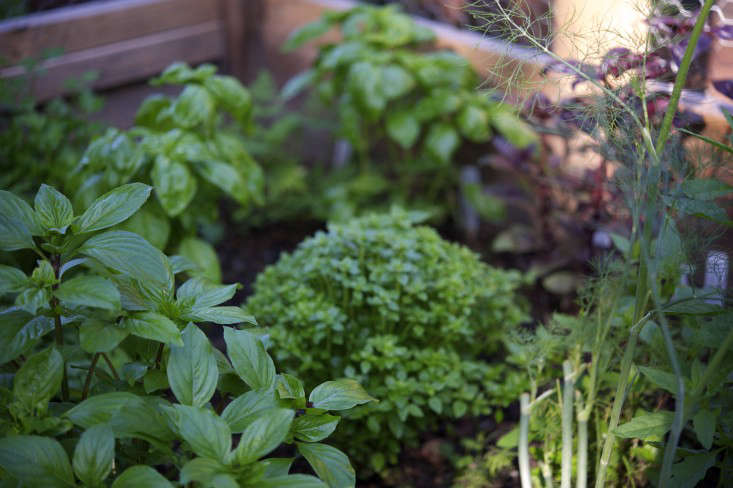Basil (Ocimum basilicum): “Tomato’s Best Friend”
Basil is all about freshness. The herb’s associations with summer are so strong that dried basil is unthinkable. Starting from seed? Sow basil six weeks before the last frost. This will ensure a steady supply for summertime suppers.
Basil needs to be added to cooked food at the end to keep its color and freshness or eaten shredded and raw with oozing mozzarella and perfectly ripe tomatoes. So it’s very important to have a good supply of this life-enhancing herb all summer long.
Basil has attracted its fair share of myths and legends, as well as a macabre tale in verse by Keats: Isabella, or the Pot of Basil. It is also said to be a mood enhancer and as a cousin of mint, basil aids digestion.

Buying a pot of basil and keeping it on the kitchen windowsill is not a difficult thing to do, but keeping it moist enough and trimmed to perfection can be. Buying a pot and planting it by the back door is one step better; basil left outdoors shouldn’t need much watering in moderate climates.

For more, see The Novice Gardener: Growing Enough Basil to Make Pesto.

For the herbivore, growing greater quantities of basil can look fantastic intercropped with purple salad leaves. Getting past the parsimonious volumes of herbs that many of us grow will mean unlimited pesto and daily herb salads: Mix different varieties of basil with the young leaves of spinach, chard, and beetroot, as well as wild rocket, mint, and fennel.

A word on picking: all herbs like a trim but do not snip carelessly with basil or you may overdo it, leaving the thicker leaves and stalks at the bottom of the plant. Pinch or cut tender new leaves forming at the top, but don’t be greedy if you want to keep your plants in good shape.

In northern climes, basil can be difficult to grow outdoors but does very well on a sunny windowsill or in a greenhouse. Hot, humid, and steamy are its ideal conditions, so give it plenty of light and water.
Cheat Sheet
- Basil will not be happy growing outdoors unless it is genuinely warm and you are happy sitting out yourself.
- Best grown with salad crops, basil likes rich, damp, though well-drained soil, making it an awkward companion in the herb garden.
- The fresh taste of basil is reminiscent of long lunches near the Mediterranean. Yet its fragrance is repellant to insects. Kept on a sunny kitchen windowsill, basil is value-added.
Keep It Alive
- Do not water basil at night: Cold and damp are anathemas. If growing in the garden, start plants off indoors in mid-spring and put them out in June or July.
- Growing zones 4-10, but best grown as an annual. Leaves go black in the first frost.
- Harvest basil before it flowers, to encourage side shoots.

Frequent trimming will keep basil bushy: if grown in a pot in a prominent place, a basil plant’s looks will soon betray neglect. Even a heavy dose of water will restore it in minutes from wan inertia to its usual vitality.
Though basil repels insects that humans consider pests, it is a magnet for white fly when grown near tomatoes. They like both, but prefer basil, which bears up to an infestation with more success than a tomato. It is a good companion to eggplant for the same reason.
Besides sweet basil (the most commonly grown sort for flavor), it comes in all shapes and sizes. Large-leaved looks more like lettuce and the smaller varieties are neat and mound-forming. Of these, Greek basil is popular as a pot plant and Thai basil has a strong flavor of aniseed. The underside of the leaves is purple. Lemon basil is useful in salads.
Read More
Planning an edible garden? For more help in growing and caring for basil, see Sweet Basil: A Field Guide. For garden layout and design ideas, see Edible Gardens 101: A Field Guide. And see our curated growing guides to Edible Plants, including Thyme, Cilantro, and Spinach, for starters.
We’ve got it covered:
- Hardscaping 101: Edible Gardens
- Everything You Need to Know About Cottage Gardens
- Hardscaping 101: Raised Garden Beds
Finally, get more ideas on how to successfully plant, grow, and care for sweet basil with our Sweet Basil: A Field Guide.
Interested in other edible plants for your garden? Get more ideas on how to plant, grow, and care for various edible plants (including flowers, herbs and vegetables) with our Edible Plants: A Field Guide.













Have a Question or Comment About This Post?
Join the conversation (0)